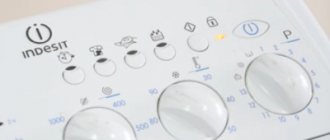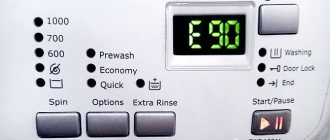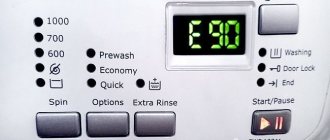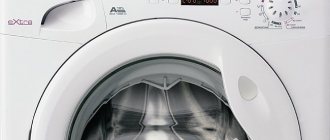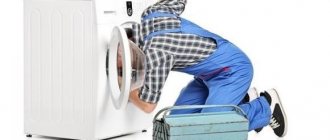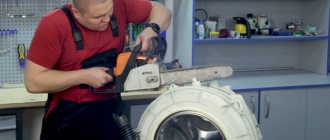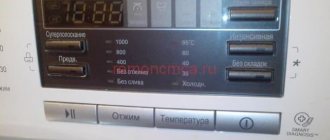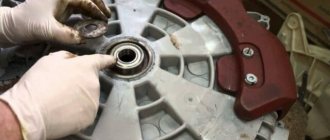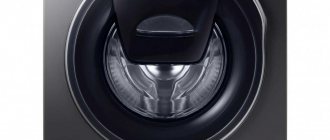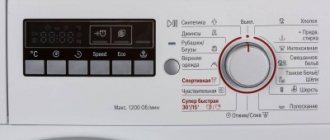The advantage of modern Whirlpool washing machines is that they can not only independently detect a breakdown, but tell their owner about it.
Smart technology is equipped with a self-diagnosis system. Once a problem is detected, the corresponding code is displayed on the electronic display.
Read our article about what the error codes in the Whirlpool washing machine mean, how to decipher them and what to do after that.
Washing machine display
If a problem is detected, the washing machine stops working and immediately displays an error message. Signaling methods depend on the specific model, rather, on its age. Most new models are equipped with a display with a segment indicator on which one or another code is displayed.
Most old cars also have a built-in diagnostic system, only the results of its operation are communicated to the user in a different way, by turning on the lamps on the display panel. If you look at the documentation for the machine, you can easily find a table there that allows you to clearly determine the type of error and identify the faulty unit.
Washing machines without a display use a lack of water supply indicator and a number of operating mode indicators to display the error code:
- prewash,
- wash,
- rinsing,
- stop,
- spin
In addition to them, indicators are used to indicate an open hatch and a dirty drain filter. Combinations of these lamps with the “Service” lamp make it possible to clearly identify a breakdown.
It doesn’t matter how exactly the device signals an error, as soon as this occurs, you need to immediately take measures to correct the situation. It is important to understand that ignoring even a seemingly insignificant error may lead to the need to replace a number of expensive device components in the near future.
Call the master
There are problems that you cannot cope with on your own. They require specialist help.
For example, you should contact a specialist if the heating element or electronic module breaks down . You can find a specialist by looking at an ad posted on the Internet or in a newspaper.
To avoid meeting with scammers, you need to study the reviews that other clients leave about the selected specialist. It’s good if they are posted on third-party sites.
You need to pay for the work only upon completion of it . You must ask the technician for a receipt and a warranty for the replaced parts. The cost of the work depends on its complexity. Prices start from 1,500 rubles for replacing a pressure switch and end at 6,000-7,000 rubles for repairing a control board.
If the machine is under warranty, you must contact the service center. In this case, the repair will be performed free of charge.
Service test
The Whirlpool washing machine automatically tests the main components and assemblies, however, the diagnostic program can be forced to start. This can be useful if questions arise regarding the operation of the machine (the device takes too long to draw water at normal pressure in the system, the drain is too noisy, etc.).
The classic washing machine test is started using the following sequence of actions:
- Launching the "Drain" program.
- Cancel the program.
- Selecting the “Drain” program without starting.
- Five presses of the soak button.
As a result of these actions, the device will begin a test wash. During the test, the drum will be filled, rotation will begin, water will be heated, drained, and spinned. If you need to skip a step, you just need to press the soak button once.
As soon as the program runs on the display (for machines without a display, a combination on the display panel), an error code corresponding to the detected malfunction will be displayed.
FH (F01)
If the Whirlpool washing machine displays error FH (F01), this means that water is not entering the loading tank or that insufficient water has accumulated. What reasons lead to this error?
- Low water pressure in the system.
- The water supply tap is not fully open.
- The inlet valve is clogged.
- Incorrect location of the siphon, which led to self-draining of water.
- The pressure switch is faulty.
- The pump, valve, and other parts of the plumbing system inside the unit require maintenance.
- There may be a malfunction in the electrical system of the washing machine.
Top Loading Whirlpool Machine
List of the most common breakdowns
Since a modern washing machine is a complex device, it consists of a number of components and assemblies, the list of potential breakdowns is extremely extensive. Among other things, there are a number of specific malfunctions that occur most often:
- blockages in the drain tract,
- jamming or breakdown of the pump,
- leaking tank seals,
- wear of electric motor brushes,
- belt breakage (in belt-driven machines),
- bearing wear,
- failure of the heater or thermostat,
- various failures of the control module.
Another common problem that is typical for both vertical loading machines and traditional front-loaders is the entry of foreign objects into the tank. Despite the apparent insignificance of the incident, in most cases, to solve the problem you will have to almost completely disassemble the washing machine.
Let's deal with light bulbs
The LEDs on the control panel of older Whirlpool models are located above the program switch knob. You need to count the light bulbs from left to right. So, the first indicator will be “No water supply”, the second will be “Pre-wash”, the third will be “Wash”, the fourth will be “Rinse”, the fifth will be “Water Hold”, the sixth will be “Drain/Spin”, the seventh will be “Door Open”. As for the lower ones, the eighth is considered the “Clean filter” diode, the ninth is “Service”.
It is through the blinking of some of these nine lights that the technology indicates a failure that has occurred in the system. It is necessary to count which LEDs are lit and figure out what kind of malfunction is indicated by a Whirlpool washing machine without a display.
Reset error
The appearance of an error message is not always a sign of a serious accident. The reason for such a situation could be, for example, a failure caused by a voltage drop. If the error appears for the first time, there is no need to panic; first, you should try to reset the error. A few simple steps will restore the device's functionality or eliminate the possibility of an accidental system failure.
To reset the error you need to do the following:
- disconnect the washing machine from the network (unplug the plug from the socket)
- keep it switched off for at least 15 minutes,
- turn it on again and try to continue washing.
If there was a failure, the machine will continue to work normally, otherwise you will have to study the instructions, figure out what this error means and look for a way to solve the problem.
Causes of failure and ways to resolve the problem
In very rare cases, a malfunction of a Whirlpool washing machine may be due to an accidental coincidence. In this case, the control board freezes and operation stops.
To reboot, it may be enough to unplug the Whirlpool washing machine for a quarter of an hour, and then turn it on again.
If the problem is one-time, work will be restored. Otherwise, it will be necessary to carry out high-quality diagnostics and identify the exact cause of the failure.
You should also inspect the buttons on the control panel to make sure that none of them (especially Spin) are jammed. If it literally failed, then that could be the problem.
Tachometer
In the case when the Whirlpool washing machine does not start to rotate the drum when starting up and displays F06, then with a high degree of probability this may indicate an error in the operation of the tachometer. To accurately analyze the situation, you need to gain access to the detail. If the tachometer is burned out, it is replaced with a new one.
The tachometer is located in Whirlpool washing machines on the motor shaft. It is accessed from the rear wall.
One of the possible problems is in the video:
Motor brushes
If the motor brushes are worn out, the Whirlpool machine may not be able to gain speed during the spin phase. In advanced situations, rotation may not occur at all. If there is a problem with the brushes, sparking may even occur.
Brushes in an electric motor are consumables. During the operation of the Whirlpool washing machine, they gradually wear out, becoming smaller, and can no longer perform their declared functions.
In this case, the solution to the problem is to replace the brushes with new ones. To do this, you need to gain access to the engine itself, remove it from the mounting socket, and carry out repair work. Replace brushes only in pairs, even if the second one is not too worn.
How to replace brushes and what to pay attention to - see the video:
Control module
A breakdown in the Whirlpool control module can be associated either with the burnout of individual elements or with the need to resolder the tracks. For an accurate analysis, you need to remove the control module in order to carry out high-quality diagnostics by checking the triac, resistor, and relay.
If damaged elements are identified, they are replaced with new ones. In cases where the board has been severely damaged and there are extensive melted areas, it may be necessary to replace it completely.
Bearings
With prolonged use of the Whirlpool washing machine, wear of the bearing assembly is possible. Such a breakdown can also be manifested by displaying the F06 coding on the display.
If the oil seal becomes leaky or loose due to vibrations, then water may seep into the motor. A washing machine with loose bearings does not operate stably, rattles and vibrates strongly, especially during the spin cycle.
Visually, water leakage from the seal can be seen when partially disassembling the Whirlpool washing machine. Such a failure requires replacement of the bearings. In some models with a non-separable tank design, it may even be necessary to replace the entire assembly.
Motor
If there is a problem with the motor itself, the Whirlpool washing machine may not spin the drum at all and issue F06. This situation can occur if there is a break or short circuit in the engine itself. This problem cannot be repaired - the motor must be completely replaced.
Fault codes
The machine signals all detected faults using error codes. Most often this is a letter of the Latin alphabet and two numbers after it.
e01
If the washing machine indicator displays error e01, on some FDL or FDU models, this means that the loading hatch is open. The reason for the message to appear may be either a truly open hatch or a faulty lock. To determine what exactly is causing the error, just open the door and close it again, trying to press it harder. If the message disappears, do not worry, otherwise you will have to disassemble the car and change the blocker.
f01 (FH)
This message indicates that the machine cannot draw water normally. There are several reasons for the error to occur. This could be a simple lack of pressure in the water supply, contamination of the filter mesh, a bend or violation of the integrity of the hose, a broken valve, or improper operation of the pressure switch. To eliminate the breakdown, you should make sure that there is water in the water supply, remove and clean the inlet filter, and possibly replace the sensor or valve.
f02
The “AquaStop” sensor has triggered – the water supply has stopped. This happens if the machine detects a leak in the pan or the inlet valve is blocked. First of all, you should make sure there are no leaks, then check the functionality of the valve.
f03
A common situation is that after a wash or rinse cycle, instead of draining the water and continuing to operate, the machine displays error message f03 (e03, FP). Any of these codes indicates problems that have arisen in the drainage system. The reason may be: blockage of the drain tract, clogged filter, pump failure.
Eliminating the error should begin by checking the drain hose and sewer for blockages, then check and, if necessary, clean the drain filter. If there is no result, you need to test the drain pump.
f06
It often happens, especially during spinning, that the engine does not reach the required speed or does not work at all, and error f06 appears on the display. The reason for this situation is a malfunction of the tachogenerator. This device is attached to the motor shaft and controls its speed. Frequent breakdowns include a spring washer flying out of its socket or damaged wiring.
f07
This error is a signal of a malfunction in the engine control system. Possible causes include a broken wiring or failure of the control triac.
f08
The appearance of error f08 (f04, f05, f12) on the washing machine display clearly indicates an unsuccessful attempt to heat the water. Most often, the culprit for this is the heating element - heating element. Sometimes the cause of this error is a non-working thermostat or controller.
To correct the situation, you will have to partially disassemble the device, check the components that regulate the temperature and provide heating, and replace the burnt-out heater or controller. On some washing machines, this error may “appear” as e05 , but this does not change its essence.
f09
If the system detects too high a water level in the tank, it signals this with error code f09. A situation is possible when the water actually overflows the tank and there is an error at its normal level. In the first case, the problem is caused by a malfunction of the inlet valve; it does not close; in the second, the water level sensor (pressostat) is broken. The valve will have to be removed, checked for clogging, and the control solenoids will have to be checked. If the sensor is at fault, it will most likely need to be replaced.
f10
A message with this code (or its analogues: f15, f26, f27, e06) indicates a problem with the electric motor. The engine does not work normally in a number of cases. First of all, the reason may be in itself (short circuit or break in the winding), but this does not happen often. Basically, the problem is a violation of the integrity of the wiring or burnout of the triac. It is also worth checking the functionality of the temperature sensor; it can block the engine from starting.
f11
Power supply problems can cause error f11 or f19. Typically, these errors occur when the voltage drops below a critical level. It is worth noting that new cars are more demanding on power supply parameters; in small towns where the voltage often “jumps” it is better to connect the car through a stabilizer.
f13
Water is slowly poured into the tank. There can be several reasons for this error to appear, most often their source is outside the machine - lack of pressure in the water supply or a clogged hose. If the pressure is really small, there is nothing left to do but postpone the wash. Next, you should pay attention to the cleanliness of the hose, the intake filter mesh and the detergent tray. Many people do not pay attention to this, but the tray can become clogged, especially if low-quality powder is used.
f14
This message indicates problems with the control board. There are a great many of them. For example, failure of electronic circuit components, open circuit or failure in a storage device. This error is unlikely to be corrected on your own; you will have to re-flash the controller, and perhaps change the entire board.
f16
Failure of the control system, which can be caused by a violation of the integrity of the wiring inside the machine or failure of the controller. To solve the problem, it is worth disassembling the car, ringing the conductors, and cleaning the oxidized contacts. If this does not help, you need to change the control module board.
f16 (Fod)
Excessive foaming can cause serious damage to your washing machine. The appearance of this error signals exactly this - the powder used creates too much foam. The solution is simple - just change the detergent and you can continue washing.
f22
The cause of this error can be a number of malfunctions. It can occur if water flows slowly into the tank or it cannot be heated. Accordingly, when receiving this message, you need to check the intake valve, intake filter mesh, wiring condition and heater.
f23
The essence of error f23 can be described as follows: the system cannot “understand” whether the tank is full or not. With a high degree of probability, the culprit in this situation is the water level sensor (pressure switch). In rare cases, the cause may be damage to the wiring going to it or a violation of the integrity of the tube. To get rid of the error, you need to make sure that the wiring is intact, and if necessary, change the sensor.
f31
This error appears only on new machines, for example, the Whirlpool AWE series, its essence is that the device cannot update the software via the Internet. The reason may be a lack of network connection or incorrect settings.
Designations of flashing indicators on a device without a display
If the Whirlpool washing machine is not equipped with an electronic display, then error codes will be displayed as flickering indicators on the light panel:
LED No. 1 is on - water supply error. It is necessary to check the operation of the filling system and pressure switch.- LEDs No. 5 and No. 9 are on - the machine has leaked, the Aqua-stop system has activated.
- LEDs No. 5, No. 6, No. 8 are on - there is a problem in the drainage system, the water does not go into the sewer pipe. It is necessary to check the pump, hose and drain filter.
- LEDs No. 4 and No. 9 are on - the heating sensor is broken or there is an open circuit in the heating system.
- Light bulbs No. 4, No. 6 and No. 9 are illuminated - the heating element is faulty (the water does not heat up).
- Lights No. 4, No. 5 and No. 9 are illuminated - the tachometer is faulty.
- Lights No. 4, No. 5 and No. 6 are illuminated - the motor is faulty.
- Indicators No. 3 and No. 9 are illuminated - the heating element or pressure switch is faulty.
- Diodes No. 3, No. 4 and No. 9 are on - problems in the system responsible for heating the water (you need to check the temperature sensor or heating element).
- Diodes No. 3, No. 4, No. 5 and No. 9 are lit - water is drawn into the drum too slowly.
- Diodes No. 3, No. 4, No. 5 and No. 9 are lit - a breakdown or malfunction of the control board.
- Diodes No. 3, No. 4, No. 5, No. 6 and No. 9 are lit - you need to check the tachometer, graphite brushes or control board.
- Light bulbs No. 2, No. 5 and No. 9 are illuminated - an excessive amount of foam.
- Lights No. 2, No. 3, No. 4 and No. 9 are illuminated - the drum does not rotate due to a foreign object getting inside.
Correcting washing machine errors
The appearance of any of the above errors on the washing machine screen should be a signal to the owner. Even if an error appears and disappears, this does not mean that everything is normal; you need to look for the cause before the problem gets worse. What to do is up to the owner to decide; you can call a mechanic, take the car to a workshop, or take on the work yourself.
Of course, you can disassemble the device yourself only if you have the appropriate knowledge and skills, and the warranty period for the device has expired. Repairing a car is a complicated matter, but it should be noted that doing the work yourself is a good way to save money, because you will only have to pay for the parts that are out of order.
The vast majority of malfunctions can only be eliminated by partially or completely disassembling the device; before starting work, you should carefully study the instructions for the machine and watch a video of disassembling a specific model. It would also be a good idea to arm yourself with a camera or phone with a camera. Photographic recording of each action will significantly facilitate subsequent assembly and will allow you to avoid gross mistakes.
Checking SM details
If you decide to start repairing it yourself, you should start inspecting the equipment. Code F23 is not the simplest. To understand how to deal with the problem, you should diagnose the internal parts of the SMA. To eliminate the error, you will have to dismantle several elements of the washing machine. If you doubt whether you can cope with the upcoming work, it is better to call an AMS repair specialist for help.
The first step is to check the pressure switch. The water level sensor is located under the top cover of the Whirlpool washing machine, on one of the walls. What to do after gaining access to the pressure switch?
- Carefully inspect the element, check that there are no defects on its body.
- Disconnect the pressure switch from the washing machine body and look for any blockages in the tube.
- Blow lightly into the tube - you should hear characteristic clicks.
- If you have a multimeter, test the contacts of the pressure switch with a tester.
If the water level sensor has completely passed the test and there is no need to repair it, you should inspect the heating element of the washing machine. The heater is located at the bottom of the tank body, behind the rear wall. It is not always possible to determine the breakdown of an element during a visual inspection. The heating element is tested with a multimeter, and the resistance of the heater is measured. The faulty element should be replaced with a new one.
The most difficult error to resolve is if it is caused by damage to the control module. To repair the main control unit, you must have a certain amount of knowledge and skills. To diagnose the control board you will need special tools. Perhaps the problem is a failed resistor, an algorithm failure, etc. If you have little knowledge of connecting electronic circuits, it is better not to attempt repairs yourself, but to invite a specialist.
Interesting:
- Error codes for AEG washing machines
- Whirlpool dishwasher error codes
- Whirlpool washing machine errors without display
- Gorenje washing machine error codes
- Bosch dishwasher errors
- Miele dishwasher errors
Reader comments
Share your opinion - leave a comment
Some troubleshooting tips
Often Whirlpool washing machine errors appear spontaneously, seemingly for no apparent reason, but many of them, in particular those related to poor drain performance, can be the result of careless handling of the device. The occurrence of a number of malfunctions can be prevented; to do this, it is worth using a few tips.
- All models of Whirlpool washing machines have a drain filter. This simple device is designed to protect the drainage path from debris, threads, and scraps of fabric. To ensure that drainage errors occur as rarely as possible, you should regularly remove and clean the filter. The frequency of cleaning is indicated in the instructions for each specific model; in any case, the procedure must be performed at least two to three times a year.
- Caked detergent can clog the ducts inside the machine, causing the program to stop unexpectedly. It's easy to avoid this. You just need to periodically remove the powder tray and rinse it with running water.
- It is worth inspecting and, if necessary, cleaning the intake filter at least twice a year. This is a mesh located at the entrance to the car. The frequency of cleaning largely depends on the condition of the plumbing and the quality of water in the system. A dirty mesh can cause water to flow slowly into the drum or stop completely.
- After each wash, when the laundry has already been removed, you should not immediately close the door; you should leave it ajar so that the “insides” of the machine dry out.
- Washing with hot water helps clean the inside of the machine. It is useful to sometimes run a wash program at 95 degrees with a small amount of detergent added. This will remove dirt accumulated in the drum and pipes.
- It is important to monitor the condition of the drain hose. This is one of the weakest points of the car. You can accidentally step on it, place a heavy piece of furniture, or bend it too much. Kinks and blockages are a common cause of faulty drainage.
- The condition of the inlet hose is equally important. The appearance of kinks and cracks is unacceptable; such a hose must be replaced immediately.
- To avoid leaks during washing, you need to regularly monitor the condition of the hatch cuff. It must be soft, elastic and always intact. To increase the service life of the cuff, it is recommended to wipe it with a damp cloth after washing.
In order for the machine to serve for a long time and have an attractive appearance, its surface must be periodically cleaned. A damp cloth is suitable for this. If serious contamination occurs, you can use cleaning products, but they should not contain abrasive particles, otherwise the panels may be scratched, which will affect the appearance of the device.
The appearance of errors on the washing machine display is not a reason to panic, it is a signal to the owner, a reminder that the device requires care. If you keep the machine clean, periodically clean it and do not allow water to stagnate inside, errors will rarely occur, and the machine will last a long time.
Let's deal with light bulbs
The LEDs on the control panel of older Whirlpool models are located above the program switch knob. You need to count the light bulbs from left to right. So, the first indicator will be “No water supply”, the second will be “Pre-wash”, the third will be “Wash”, the fourth will be “Rinse”, the fifth will be “Water Hold”, the sixth will be “Drain/Spin”, the seventh will be “Door Open”. As for the lower ones, the eighth is considered the “Clean filter” diode, the ninth is “Service”.
It is through the blinking of some of these nine lights that the technology indicates a failure that has occurred in the system. It is necessary to count which LEDs are lit and figure out what kind of malfunction is indicated by a Whirlpool washing machine without a display.
Let's check the heating element
Often error F08 appears as a result of a heater malfunction. You can check the heating element very quickly. To do this, perform the following algorithm of actions (the sequence of steps described will help owners of machines with a front-loading type; for vertical machines, the manipulations will be slightly different):
- turn off the power to the washing machine;
- disconnect the drain and inlet hoses from the house utilities;
- provide yourself with consolidated access to the rear wall of the washing machine;
- unscrew the bolts holding the back cover;
- Unscrew the bracket covering the heater.
Important! The heating element is located at the bottom of the machine, under a plastic casing; only by removing the protective cover can you gain access to the contacts of the heating element.
Next, disconnect the power contacts, take a multimeter and connect its probes to the terminals of the heating element, set the resistance on the device to 200 Ohms, analyze the results. If the value on the multimeter screen remains approximately the same as it was set, then the heater is fully operational. When the number 1 appears, this indicates a break inside the part and will have to be replaced. When the device displays the number 0 (or a number very close to zero), it means that a short circuit of the heater can be diagnosed, in which case you will also have to install a new heating element.
If the heater passes the first test with a multimeter, just in case, check it for breakdowns. To do this, switch the test device to buzzer mode. You will be notified that the mode has been selected correctly by a lit light and a characteristic signal that will appear when the wires are connected. Connect one multimeter probe to the heating element terminal, and attach the second to the element body. If the device does not make any sounds, everything is fine; if a characteristic squeak is heard, there are breakdowns in the body of the part, and the heater will have to be replaced.
Let's check the thermistor
If the heating element has been fully tested and has proven that it copes with its functions perfectly, it’s time to check the thermistor. Just, it is located between the contacts of the heater. To remove the temperature sensor, perform the following manipulations:
- remove the chip with wiring from the heater contacts;
- slightly loosen the nut that holds the heating element;
- Carefully remove the thermostat from the housing.
The temperature sensor is a small metal cylinder. After the thermistor is removed from the washer body, you need to check the resistance in it using a tester.
- switch the multimeter to resistance determination mode;
- hook the probes of the device to the contacts of the temperature sensor. For example, if the temperature is 200°C, the resistance should be displayed on the screen, the value of which will be 6000 Ohms;
- lower the thermistor into warm water, watch the numbers change on the device screen. If the temperature sensor is working properly, the resistance will decrease, so at 50°C it will be about 1350 Ohms.
When the temperature sensor fails, the old part should be replaced. The thermostat cannot be repaired. If the element is fully operational, we continue the diagnostics further.
We will inspect and test the pressure switch
It is easy to provide access to the water level sensor of the Whirlpool washing machine; it is located in the upper part of the unit, directly under the lid. Very rarely the pressure switch is located at the bottom. To get to the part, carefully unscrew the mounting screws and remove the upper wall of the SMA housing, after which the algorithm of actions will be as follows:
- prepare a tube whose diameter will correspond to the diameter of the pressure switch hose;
- disconnect the fitting by carefully loosening the clamp;
- Attach a tube to the pressure hose and blow into it;
- when the pressure switch is working, you will hear 1 or 3 characteristic clicks;
- check the sensor for any damage;
- examine the fitting for blockages;
- When a blockage is detected, flush the hose with a stream of water from the tap.
If after an external examination no defects were identified, you need to check the pressure switch with a multimeter. The device is switched to resistance measurement mode, the tester probes are connected to the sensor contacts. If the values on the screen change, it means that the contacts are actuated and the pressure switch is working. When the resistance value remains fixed, it means that the liquid level sensor has failed.
So, when you have checked the functionality of the main elements that can trigger the F08 error code, no faults have been identified, you should invite a professional to determine the root cause of the code. After all, the problem may come from the main control board, and it is not recommended to deal with it yourself.
Recommendations
When carrying out repair and diagnostic activities, the following expert advice can help:
- The case can only be opened when communications are disconnected.
- You should not open a washing machine under warranty yourself - you need to contact the service department.
- Before disassembling, it is advisable to drain the remaining water from the tank.
- Before you begin disassembling the case, you need to make sure you have the required tools and a multimeter for diagnostics.
Finding the tachometer
In all Whirlpool washing machine models, the tachogenerator is located on the rotating motor shaft. To get to the motor, you need to remove the rear wall of the unit (by unscrewing the fasteners and prying the panel with a screwdriver) and remove the drive belt. First turn off the power to the equipment and disconnect it from the water supply.
Important! Take your time to disassemble the machine, first carefully check the spin mode button - if it is pressed inward, the problem may lie there.
On the engine shaft you will see an iron ring with two wires - this is the tachogenerator or Hall sensor. It cannot be dismantled without removing the engine from the machine. Therefore, if you do not have experience in electrical installation, it is better to entrust the work to a specialist. Otherwise, during experimental repairs, there is a high risk of not correcting, but of aggravating the problem.
